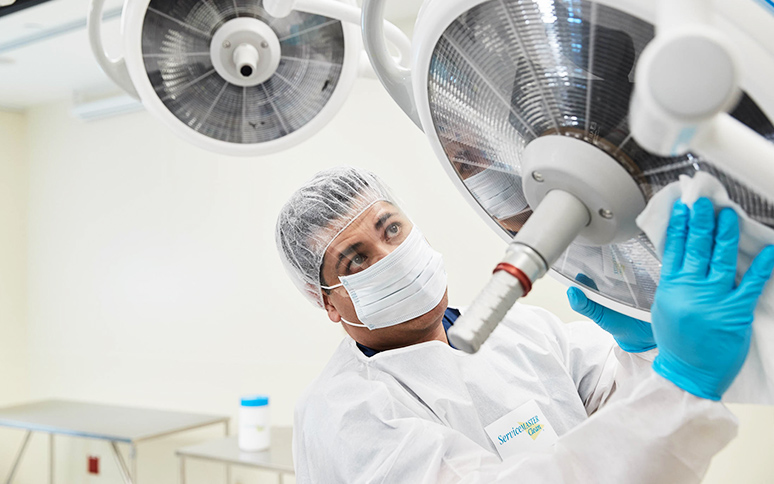Choosing the Right Hospital Grade Disinfectant
Staff and patient well-being is of primary importance if you manage a healthcare practice, and maintaining a properly cleaned facility plays a significant role in helping to keep both practitioners and patients healthy and the environment safe. You already know that medical, dental and surgical environments require a greater degree of cleanliness and disinfection than the average commercial facility, but do you know the right disinfectants to use in your unique practice?
Even if you hire an outside company to do the cleaning for you, you should understand the products they use to ensure their level of disinfection is appropriate for your specific facility. You should consider each of the following factors recommended by Centers for Disease Control and Prevention (CDC) when evaluating disinfectants for your healthcare facility:
- Mode of action
- Efficacy
- Compatibility
- Cost
- Current health and safety standards
- The nature and degree of contamination
With extensive experience providing patient-centered cleaning services for healthcare facilities, the technicians at ServiceMaster Clean are experts in the science and skill of disinfecting. Use this guide to learn the primary differences between two essential disinfectants – quaternary and sporicidal – so you can make the best janitorial choices to help protect your patients and staff and keep your facility safe.
What is Quaternary Disinfectant?
Quaternary ammonium compounds, or "quats" as they're called in the healthcare industry, are active ingredients used in detergents and chemical disinfectants to kill harmful pathogens like fungi, amoebas, mold, many types of microbes, and some strains of viruses.
When used properly, quats are ideal for infection-control in dentist and physician offices, waiting rooms and clinics, and they can be used on just about any hard, nonporous surface. These readily available solutions are also trusted sanitizing agents for surfaces that come into contact with food. Quaternary disinfectants are not effective at removing harmful bacterial endospores that can spread infection, however.
Quat-based products are a top disinfectant choice for most health facilities because every solution must be registered with the United States Environmental Protection Agency (EPA) or approved by the U.S. Food & Drug Administration (FDA) to receive the quaternary label. Refer to the categorized lists of EPA-registered disinfectants to find cleaning products that serve your facilities' specific needs.
Uses and Warnings
Although many of the quaternary disinfectants available today are considered a one-step treatment, we recommend removing any visible soil or debris from surfaces before applying quats for best results. Janitorial technicians should refer to product manufacturers' instructions for correct dilution rates, application methods and contact times. Exposure to the chemicals in quats can cause dermatitis and respiratory discomfort, so it's crucial for anyone handling these agents to wear proper protection in the form of gloves, breathing masks, goggles and long-sleeved clothing.
In recent years, bacterial resistance to quats has been of increasing concern, according to a report from the National Center for Biotechnology Information (NCBI), a division of the National Library of Medicine (NLM) at the National Institutes of Health (NIH). To make sure you continually meet healthcare facility safety standards and best practices, remain alert to updates and changes reported in the efficacy of the cleaning products used in your facility.
What is a Sporicidal Disinfectant?
As you may remember, quats do not kill endospore-forming bacteria that can lead to the dangerous spread of infection. Because endospores are the most difficult micro-organisms to destroy, you'll need a powerful disinfectant with sporicidal properties if your facility is susceptible to these kinds of micro-organisms.
Hospital-grade sporicidal disinfectant is best used for terminal cleaning in critical environments like surgical centers and operating rooms where patients are highly susceptible to infection. Cleaning crews must take extra precautions when cleaning these environments and use proper techniques to perform thorough, high-level disinfection in order to prevent cross-contamination. Sporicidal disinfectant will only be effective when used properly, so cleaning technicians should refer to the product manufacturers' labels for specific instructions.
Uses and Warnings
Due to their high toxicity levels, sporicidal disinfectants pose a greater risk to health and safety during use. To avoid contact with the chemicals, cleaning staff should always be fully equipped with protective gear. Some harsh sporicidal chemicals have been known to cause damage and discoloration to certain exposed surfaces, as well, so always refer to product warnings before use.
Fortunately, high-level sporicidal disinfection isn't required for all healthcare environments. In non-surgical practices, quaternary disinfectants are usually sufficient for regular cleaning, while sporicidal disinfectants are kept on reserve in case of bacterial resistance or disease outbreak.
Rather than keeping up with industry recommendations around each cleaning product available, the easiest way to make sure you're using the right disinfectants for your specific facility is to hire a professional cleaning service with extensive experience serving the healthcare industry. Contact the experts in healthcare cleaning at ServiceMaster Clean to discuss your facility's unique needs and start customizing your quality cleaning plan today.







